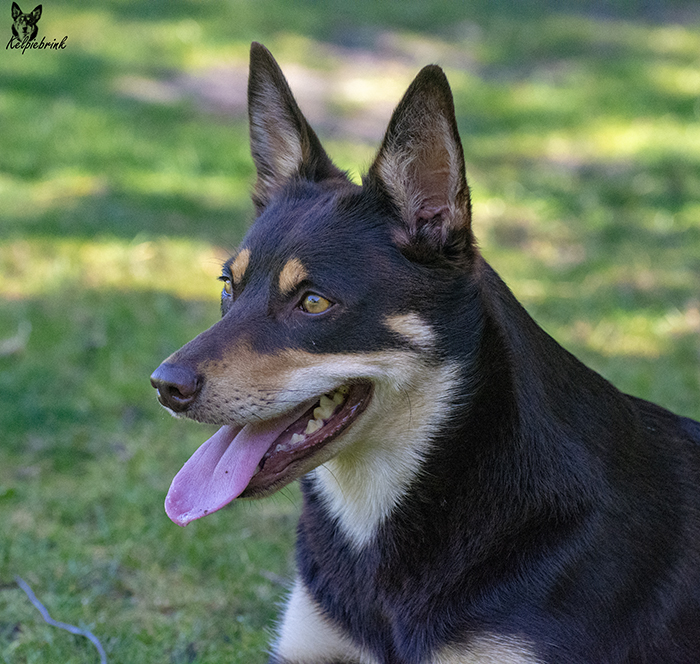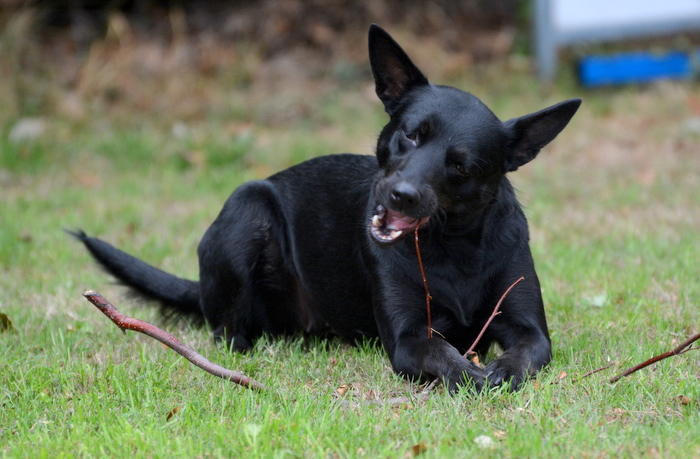THE PICTURES USED ARE PHOTOS TO ENLIVEN THE TEXT AND HAVE NOTHING TO DO WITH THE TEXT ITSELF.
Epilepsy in the kelpie
Epilepsy also occurs in the kelpie. It seems to occur more in the working lines than in the Australian kelpie but because the origins are the same and the lines are often intertwined we can assume that it is also more common in the Australian Kelpie than is known.
Fortunately, it is not nearly as bad as in certain other breeds such as the Border Collie. Sometimes it skips entire generations before reappearing in a line.
This combined with the lack of clarity regarding inheritance makes it difficult to avoid epilepsy within the breed altogether.





Introduction
The syndrome epilepsy is observed in 1 to 2% of all dogs. The exact frequency varies by breed, region and country. It is more common in the breed groups shepherds, hunting dogs and canines. There are also outliers within the different breed groups. The frequency also varies, especially in genetic epilepsy, over time.
Classification based on manifestation
Epileptic or epileptiform seizures result from abnormal electrical activity in the cerebral cortex or subcortical regions, such as the thalamus and brainstem. If both hemispheres of the brain are involved, we speak of a generalised seizure and if only a (small) part of the cerebral cortex or subcortical regions are involved, we speak of a partial or focal seizure.

Generalised seizures:
Both hemispheres of the brain are involved.
The form we see most often is the so-called generalised tonic-clonic seizure. Basically, in all forms of generalised seizures, there is a marked loss of consciousness. As a rule, there is an introductory pre-ictal phase. Although various textbooks speak of a prodrome and aura, it is almost impossible to distinguish an aura in our pets. An aura is the phase immediately preceding the actual seizure (the ictus) and is more of an experience felt by the patient than a phase recognisable to us. This is in contrast to a prodrome where the animal may be more affectionate, busier etc. A prodrome can last from minutes to days.

The prodrome is followed by the ictus. During the ictus, the patient falls (or is already lying) on his side. First, a tonic period occurs, during which an ophistonus and tonic spasm of all four limbs can be seen. This is followed by the so-called clonic attack, which presents as cycling or jerking movements with the legs. During the ictus, during which the patient undergoes loss of consciousness, the patient may vocalise, drool, urinate and defecate . The ictal phase lasts for seconds to minutes. After the ictus, the post-ictal phase sets in. It may be absent. The phase may last seconds to days. In this, the patient is sometimes completely unable to walk, atactic, sleepy, aggressive, restless, etc. We often see some, temporary, memory loss. The ictal and post-ictal phases are particularly dramatic for dog owners, and owners rate this as a marked loss of quality of life .

Other generalised forms
Besides this classic tonic-clonic seizure, five other generalised forms can be recognised in humans, which are not always easy to recognise in our pets .
Also in these forms there is more or less a clear loss of consciousness.
The second form is a purely tonic attack with again loss of consciousness but extreme muscle rigidity.
The third form, a clonic seizure, consists of again loss of consciousness and only clonic movements with the legs.
Atonic seizures (fourth form) are characterised by a sudden loss of muscle tension.
Myoclonic seizures (fifth form) present as the sudden jerking of one or more muscle groups. The most well-known myoclonic epilepsy in dogs is Lafora in Beagles, Bassets and Dashunds . The seizure is triggered by sound or light. The sixth form are seizures. In these, the patient falls away for a very short time. Of these first five forms, only tonic and myoclonic epilepsy are reasonably well recognised by vets.

Focal or partial seizures
Focal seizures involve only a small part of the cerebral cortex or subcortical regions. It should be noted that focal seizures can also turn into generalised seizures.
Because focal seizures are sometimes difficult to recognise, they sometimes resemble so-called movement disorders, ‘movement disorders’, or paroxysms. If there is a clear loss of consciousness, it is probably epilepsy. If no clear loss of consciousness occurs, we can start talking about a paroxysm. There is quite a lot of overlap and in some disorders the pathogenesis is the same. This group of disorders is challenging even for experienced (veterinary) neurologists.

Clustering and status epilepticus
Both ‘clustering’ and status epilepticus are a form of the classic generalised seizures, but last longer and look different. Clustering refers to a short period of time (in minutes to hours), during which several seizures occur and between which, more or less, a post-ictal phase can still be recognised.
Status epilepticus refers to the situation where several seizures follow each other, with no post-ictal phase in between. Today, most authors refer to status as when the seizure or the whole cluster lasts longer than 15 minutes. Clustering and status epilepticus are life-threatening situations in which the dog owner or vet must act immediately.

Etiology
Besides classification by form, we also know a classification by cause or aetiology. A classification found in more recent veterinary textbooks assumes four groups:
1) True, primary or idiopathic epilepsy, in which a cause is thus never found.
2) Secondary epilepsy, where a detectable lesion is present intracranially.
3) Reactive epilepsy, in which seizures occur because an extracranial cause affects brain function.
4) Cryptogenic epilepsy. In the latter group, an intracranial lesion is also present but is no longer detectable.

It has recently been proposed to simplify this classification, again by analogy with the human classification. We now refer to so-called ‘true epilepsy’ and ‘false’ or ‘non-genuine epilepsy’. ‘True epilepsy’ consists of the following main groups:
1 Idiopathic epilepsy
1a. Idiopathic epilepsy with a hereditary or genetic basis. In this form, heredity is suspected based on high prevalence within a breed, family research or the actual finding of a mutation.
1b. Idiopathic epilepsy in which we cannot find the cause despite extensive research.


2 Structural epilepsy (also called secondary epilepsy). Here, a structural abnormality is present cortically or subcortically. Consider (for example) a brain tumour, trauma to the cerebral cortex, stacking diseases, inflammation, etc. Formally, Lafora, an example of a myoclonic epilepsy is therefore a structural epilepsy because it is a stacking disease. However, Lafora is one of the few forms of epilepsy where we have found the mutation responsible for it (genetic epilepsy).

In these main groups, the problem is actually intracranial.
Besides these three groups, we also know the group ‘false or non-real epilepsy’. This is also called reactive seizures. Here, a problem outside the brain, e.g. intoxication, heart failure or a metabolic problem, causes a seizure that looks like real epilepsy but is not. After all, there is nothing structurally wrong with the brain.
The major limitation of this classification is that we can rarely say with certainty that epilepsy is hereditary. And perhaps even, given dog breeding, it is undesirable to leave room for interpretation. Nevertheless, even for the malicious breeder, it is not possible to classify purebred dogs suspected of having genetic epilepsy as idiopathic if we follow the approach of Patterson et al (1989). The authors of this article clearly indicated that if a disease is more frequent in the same breed, always has the same clinical and pathological form, occurs familially and increases with inbreeding it is probably an inherited disease. Even if we have not yet found the mutation.
Genetische epilepsie
Hoewel er een voorzichtige richtlijn is dat genetische epilepsie vaak gegeneraliseerd is, kan dit geenszins als absolute stelregel worden gebruikt.
Genetische epilepsie kan focaal, gegeneraliseerd of een combinatie van focaal en gegeneraliseerd zijn.
Vaak is het een rasgebonden probleem, dat zich presenteert per ras op een voor dat ras eigen manier.
Voorbeelden zijn de Belgische herders, Border Collies, Labrador Retrievers, Engelse Springer Spaniëls etc. met allemaal hun eigen presentaties.
Wanneer kunnen we nu stellen dat een hond een idiopathische en mogelijk ook genetische epilepsie heeft? Hiervoor bestaan criteria die geen van allen 100% obligaat zijn:
1) De eerste epileptische aanval wordt gezien tussen de leeftijd van 6 maanden en pakweg 5 jaar.
2) Vaak betreft het een bekend ras met een voor dat ras bekende vorm.
3) De patiënt is gezond en tussen aanvallen door worden geen afwijkingen gevonden.
4) Er is geen duidelijke relatie tussen het optreden van een aanval en lichaamsbeweging en/of eten. Stress of bepaalde emotionele omstandigheden kunnen daarentegen de aanvallen triggeren.




